Suburb Attractions :
1. Great Wall; 2.Ming Tombs ;3.Sacred Way;4.Longqing Gorge;5. Fragrant Hills;
6.The Site of Peking Man at Zhoukoudian
Historical & Downtown Attractions:
7.Forbidden City ; 8.Summer Palace; 9.Temple of Heaven ; 10.Tian’anmen Square ;
11. Lama Temple ;12. Beijing Hutong ;13.Drum&Bell Tower ;14.Beihai park;
15.Tsinghua University ;16.Marco polo Bridge ; 17.The Ruins of Yuanmingyuan
Modern Attractions:
18.Bird Nest ;19. Water Cube ; 20.Panda Garden ;21.National Grand Theater ;
22.Beijing Aquarium ;23. CCTV tower; 24.China Millennium Monument ;
25.Happy valley Amusement park
1. Great Wall

. The Great Wall (Changcheng), totaling more than 12,000 kilometers, is the image of China throughout the world. It is the only man made object visible from the moon, and as one of the Eight Wonders of the world, the Great Wall of China lives up to its reputation.
"If you haven't climbed the Great Wall, you haven't seen China." Many of your friends who visited China before might have told you this. It is, indeed an experience of life. Who would leave the country without seeing the only construction that the American astronauts could recognise with their naked eyes, on their first flight to the Moon!
There are Badaling Section, Simatai Section, Mutianyu Section, Jinshanling Section and Gubeikou Section. Of all these five sections, the Great Wall at Badaling Section is the most famous and best preserved.
All these five sections of the Great Wall in Beijing have their own unique features:
Badaling Great Wall was the best preserved part of the Ming Great Wall. Mutianyu Great Wall is the most beautiful and green section of the Great Wall. Simatai & Jinshanling Great Wall are remarkable place for sightseeing, hiking and exploration with its fantastic scenery & precious phtopography.
Badaling Section Great Wall Admission Fee: CNY 45 (Apr. 1 to Oct.31); CNY 40 (Nov.1 to Mar.31)
Cable Car: CNY 40 (single way); CNY 60 (round trip)
Opening Hours: 06:30-19:00 (In summer); 07:00-18:00 (In winter)
"If you haven't climbed the Great Wall, you haven't seen China." Many of your friends who visited China before might have told you this. It is, indeed an experience of life. Who would leave the country without seeing the only construction that the American astronauts could recognise with their naked eyes, on their first flight to the Moon!
There are Badaling Section, Simatai Section, Mutianyu Section, Jinshanling Section and Gubeikou Section. Of all these five sections, the Great Wall at Badaling Section is the most famous and best preserved.
All these five sections of the Great Wall in Beijing have their own unique features:
Badaling Great Wall was the best preserved part of the Ming Great Wall. Mutianyu Great Wall is the most beautiful and green section of the Great Wall. Simatai & Jinshanling Great Wall are remarkable place for sightseeing, hiking and exploration with its fantastic scenery & precious phtopography.
Badaling Section Great Wall Admission Fee: CNY 45 (Apr. 1 to Oct.31); CNY 40 (Nov.1 to Mar.31)
Cable Car: CNY 40 (single way); CNY 60 (round trip)
Opening Hours: 06:30-19:00 (In summer); 07:00-18:00 (In winter)
2.Ming Tombs
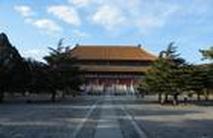
Beijing has been home to more than five feudal dynasties. Its no great surprise then, that 13 of the 16 Ming emperors have their tombs situated just outside the city.
And how thoughtful of them to make their burial place a convenient stop off for travelers en route to the Great Wall at Badaling! Covering a huge area, the Ming Tombs (Shi San Ling or literally the 13 Tombs) are located 50km North West of the city.
Spring is the best time of year to visit, when the area surrounding the vaults is alive with trees and blooming flowers. It is a good place to visit if you are interested in dynastic history.
There are just 2 tombs which have been excavated and open to the public: Dingling and Changling. Changling is the first tomb to be built. It took 2 years for renovation, and was opened in 1958. Dingling has been excavated so thoroughly that one has to get into the burial chamber itself. However, it is a very steep climb down and people who have problems with their heart or kneels are not suggested to visit the underground tomb. For wheel-chair users or those who don't want to go deep inside a tomb, We recommend Changling Tomb.
Admission Fee: Changling Tomb: CNY 30 (Nov.1 to Mar. 31); CNY 45 (Apr. 1 to Oct. 31)
Dingling Tomb: CNY40 (Nov.1 to Mar. 31); CNY 60 (Apr. 1 to Oct. 31)
Opening Hours: Changling Tomb: 08:30 to 17:30; Dingling Tomb: 08:30 to 18:00
And how thoughtful of them to make their burial place a convenient stop off for travelers en route to the Great Wall at Badaling! Covering a huge area, the Ming Tombs (Shi San Ling or literally the 13 Tombs) are located 50km North West of the city.
Spring is the best time of year to visit, when the area surrounding the vaults is alive with trees and blooming flowers. It is a good place to visit if you are interested in dynastic history.
There are just 2 tombs which have been excavated and open to the public: Dingling and Changling. Changling is the first tomb to be built. It took 2 years for renovation, and was opened in 1958. Dingling has been excavated so thoroughly that one has to get into the burial chamber itself. However, it is a very steep climb down and people who have problems with their heart or kneels are not suggested to visit the underground tomb. For wheel-chair users or those who don't want to go deep inside a tomb, We recommend Changling Tomb.
Admission Fee: Changling Tomb: CNY 30 (Nov.1 to Mar. 31); CNY 45 (Apr. 1 to Oct. 31)
Dingling Tomb: CNY40 (Nov.1 to Mar. 31); CNY 60 (Apr. 1 to Oct. 31)
Opening Hours: Changling Tomb: 08:30 to 17:30; Dingling Tomb: 08:30 to 18:00
3.Sacred Way
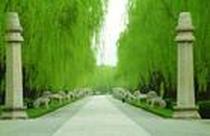
In the front part of the imperial necropolises, there usually is a Sacred Way (or Divine Road) which means the road leading to heaven. The Emperor, known as the Son of the Heaven, who came from Heaven to his country through the Sacred Way, also deservedly would return to Heaven through this road.
The road is often lined with stone statues which are important decorations of the mausoleum. These statues are usually 12 human figures (including the general, civil officials and meritorious officials) and 24 animals which are lion, camel, elephant, xiezhi (a mythological unicorn), qilin (one of the four "divine animals, the other three are dragon, phoenix and tortoise), and horse. There are 4 of each of these animals: two standing and two squatting with different meanings. Lion symbolizes awesome solemnity because of their ferocity. Camel and elephant are meant to suggest the vastness of the territory controlled by the court, because they are dependable transport in desert and tropics. Xiezhi was put there to keep evil spirits away, because it was believed to possess the sixth sense to tell right and wrong. If two men fight, a xiezhi would gore the wicked one. Qilin, an auspicious symbol, was placed on two sides. Horse, as the emperor's mount, is absolutely indispensable. It is said that these animals is supposed to change guard at midnight.
Among the many Sacred Ways, the one of Ming Tombs' is best preserved and complete. The Sacred Way starts with a huge stone memorial archway lying at the front of the area. Constructed in 1540, during the Ming Dynasty, this archway is the earliest and biggest stone archway existing in China today. Farther in, the Shengong Shengde Stele Pavilion can be seen. Inside it, there lies a 50-ton tortoise carrying a stone tablet. A white marble Huabiao (ornamental pillar) is positioned at each corner of the stele pavilion. At the top of each is stationed a mythical beast facing either inward or outward, expressing hope that the emperor will neither cling to the palace nor forget to return to the Palace to handle state affairs. Then come two Roof Pillars on each side of the road, whose surfaces are carved with the cloud design, and tops are shaped like a rounded cylinder. After the 18 pairs of stone statues which are all sculpted from whole stones, and larger than life size, comes the Dragon and Phoenix Gate. The Sacred Way was originally built to lead to the Changling mausoleum. Afterwards, twelve more mausoleums were built. It is a ten-minute bus ride from the Sacred Way to Changling.
Admission Fee: CNY 20 (Nov.1 – Mar.31); CNY 30 (Apr.1 – Oct.31)
The road is often lined with stone statues which are important decorations of the mausoleum. These statues are usually 12 human figures (including the general, civil officials and meritorious officials) and 24 animals which are lion, camel, elephant, xiezhi (a mythological unicorn), qilin (one of the four "divine animals, the other three are dragon, phoenix and tortoise), and horse. There are 4 of each of these animals: two standing and two squatting with different meanings. Lion symbolizes awesome solemnity because of their ferocity. Camel and elephant are meant to suggest the vastness of the territory controlled by the court, because they are dependable transport in desert and tropics. Xiezhi was put there to keep evil spirits away, because it was believed to possess the sixth sense to tell right and wrong. If two men fight, a xiezhi would gore the wicked one. Qilin, an auspicious symbol, was placed on two sides. Horse, as the emperor's mount, is absolutely indispensable. It is said that these animals is supposed to change guard at midnight.
Among the many Sacred Ways, the one of Ming Tombs' is best preserved and complete. The Sacred Way starts with a huge stone memorial archway lying at the front of the area. Constructed in 1540, during the Ming Dynasty, this archway is the earliest and biggest stone archway existing in China today. Farther in, the Shengong Shengde Stele Pavilion can be seen. Inside it, there lies a 50-ton tortoise carrying a stone tablet. A white marble Huabiao (ornamental pillar) is positioned at each corner of the stele pavilion. At the top of each is stationed a mythical beast facing either inward or outward, expressing hope that the emperor will neither cling to the palace nor forget to return to the Palace to handle state affairs. Then come two Roof Pillars on each side of the road, whose surfaces are carved with the cloud design, and tops are shaped like a rounded cylinder. After the 18 pairs of stone statues which are all sculpted from whole stones, and larger than life size, comes the Dragon and Phoenix Gate. The Sacred Way was originally built to lead to the Changling mausoleum. Afterwards, twelve more mausoleums were built. It is a ten-minute bus ride from the Sacred Way to Changling.
Admission Fee: CNY 20 (Nov.1 – Mar.31); CNY 30 (Apr.1 – Oct.31)
4.Longqing Gorge

North of the Badaling Great Wall and 80 kilometers (50 miles) from downtown Beijing, you can discover Longqing Gorge, in northeast Yanqing County. The gorge, reputed to be the 'Little Three Gorges', features clear waters, wooded mountains, curious stones and wonderful karst caves. The gorge's main attractions are the Longqing Gorge Cruise, Baihua (hundred Flowers) Cave, and the Shenxianyuan (Immortal) and Jingang temples.
Near the entrance, a grand waterfall plummets down 50 meters (164 feet) from the dam above. A long, dragon-shaped escalator carries visitors to the dam, where the cruise begins. On both sides, eerie mountains and strange formations inspire visitors' imaginations as they have for centuries. You can marvel at the huge, natural Buddha stone and a hill rising from the water like a great bell. Another hill, named Fengguan (Phoenix Coronet) Isle, is considered the symbol of the Longqing Gorge. Fengguan is surrounded on three sides by water and closed off by high mountains on the fourth.
Visitors can experience the four seasons, from the heat of the tropics to the heart of the northeastern China, thanks to the colorful lights and elaborately crafted flowers in Baihua Cave. In the Shenxianyuan Temple area, several huge stones halfway up the cliff resemble chessboards. It's said that rubbing on the trunk of the tree near the edge of cliff can cure illnesses, but no one dares get close because of the extreme danger. The Yuhuang Peak is the highest in the area, and the teahouse at the peak offers a wonderful position from which to appreciate the scenery. In the Jingang Temple area, a hill looking like a pen gently dips into the water as if it were clearest ink. A karst cave nearby, Minting Coins Stove, is the place where two brothers made fake money to save the poor in the Qing Dynasty (1644-1911).
Every year, the Ice and Snow Festival, held from January to February in Longqing Gorge, displays many beautiful ice lanterns. During the festival, the marvelous ice waterfall together with the lanterns attracts many visitors. Except for the Ice and Snow Festival, Longqing Gorge only opens to visitors from April 10 to November 15.
Longqing Gorge is an ideal place to do extreme sports such as bungee-jumping (CNY 150 per person), rock-climbing or abseiling (CNY 50 per person). Taking a slideway and boating cost CNY 20 per person and CNY 20 per hour. Tickets for the cruise, the Baihua Cave, the Shenxianyuan Temple and the Jingang Temple are respectively CNY 60, 10, 20 and CNY 10 per person.
Admission Fee: CNY 40
CNY 70 during the Ice and Snow Festival
Opening Hours: 07:30-16:30 January 1- the end of February
April 10-November 15
Near the entrance, a grand waterfall plummets down 50 meters (164 feet) from the dam above. A long, dragon-shaped escalator carries visitors to the dam, where the cruise begins. On both sides, eerie mountains and strange formations inspire visitors' imaginations as they have for centuries. You can marvel at the huge, natural Buddha stone and a hill rising from the water like a great bell. Another hill, named Fengguan (Phoenix Coronet) Isle, is considered the symbol of the Longqing Gorge. Fengguan is surrounded on three sides by water and closed off by high mountains on the fourth.
Visitors can experience the four seasons, from the heat of the tropics to the heart of the northeastern China, thanks to the colorful lights and elaborately crafted flowers in Baihua Cave. In the Shenxianyuan Temple area, several huge stones halfway up the cliff resemble chessboards. It's said that rubbing on the trunk of the tree near the edge of cliff can cure illnesses, but no one dares get close because of the extreme danger. The Yuhuang Peak is the highest in the area, and the teahouse at the peak offers a wonderful position from which to appreciate the scenery. In the Jingang Temple area, a hill looking like a pen gently dips into the water as if it were clearest ink. A karst cave nearby, Minting Coins Stove, is the place where two brothers made fake money to save the poor in the Qing Dynasty (1644-1911).
Every year, the Ice and Snow Festival, held from January to February in Longqing Gorge, displays many beautiful ice lanterns. During the festival, the marvelous ice waterfall together with the lanterns attracts many visitors. Except for the Ice and Snow Festival, Longqing Gorge only opens to visitors from April 10 to November 15.
Longqing Gorge is an ideal place to do extreme sports such as bungee-jumping (CNY 150 per person), rock-climbing or abseiling (CNY 50 per person). Taking a slideway and boating cost CNY 20 per person and CNY 20 per hour. Tickets for the cruise, the Baihua Cave, the Shenxianyuan Temple and the Jingang Temple are respectively CNY 60, 10, 20 and CNY 10 per person.
Admission Fee: CNY 40
CNY 70 during the Ice and Snow Festival
Opening Hours: 07:30-16:30 January 1- the end of February
April 10-November 15
5. Fragrant Hills

The Fragrant Hills Park (Xiangshan gongyuan) is located 20 kilometers northwest of Beijing and not far from the Summer Palace. The name of the park derives not from the fresh air or aroma in the area, but in the shape of the hills themselves. If you look close enough (and with a bit of imagination thrown in) you can just make out the shape of an incense burner at the peak of the hills.
The Fragrant Hills Park is also known as the Garden of Congenial Tranquility. However it is generally pretty busy here unless you escape the crowds and head into the woods. Take a chair-lift or hike up the peak itself for great views of the surrounding countryside. Once you reach "Incense burner peak" and, if you are feeling fit and brave, head off on some of the marked trails and delve into the woodlands.
The hills and woods were a favorite country retreat of the emperors. The building of Temples began here in the Jin Dynasty (1186 A.D.) and by the Qing Dynasty, (1745 A.D.) 28 had been erected in the Garden of Congenial Tranquility. In 1860 and again in 1900, the Garden was seriously destroyed by fire and many of the temples and halls ruined. Today, only some of the buildings have been restored. When the Central Committee of the Communist Party moved to Beijing from Hubei, Mao made Double Purity Villa his residence here. Inside the Villa are various displays and cultural relics. However, it's the views of the countryside which are the most attractive thing about the Park. From Ghost Fear peak on a fine day, (Ghosts apparently fear heights !) one can see the Yongding River, Luding Bridge, Prospect Hills, Summer Palace, Yuquan Hill and the outskirts of the city.
In autumn, the red leaves decorating the trees on the hillside add an extra special glow to the area.In fact, many Beijingers come here every year to collect red maple leaves (see the picture above) which they believe are auspicious (red is a symbol of good luck and happiness). Another one of the Park's attractions are the donkey rides! Not for the faint hearted!
Ticket Price: RMB10 in the peak-season, while RMB5 in the off-season.
Openning Time: 6:00-19:00
The Fragrant Hills Park is also known as the Garden of Congenial Tranquility. However it is generally pretty busy here unless you escape the crowds and head into the woods. Take a chair-lift or hike up the peak itself for great views of the surrounding countryside. Once you reach "Incense burner peak" and, if you are feeling fit and brave, head off on some of the marked trails and delve into the woodlands.
The hills and woods were a favorite country retreat of the emperors. The building of Temples began here in the Jin Dynasty (1186 A.D.) and by the Qing Dynasty, (1745 A.D.) 28 had been erected in the Garden of Congenial Tranquility. In 1860 and again in 1900, the Garden was seriously destroyed by fire and many of the temples and halls ruined. Today, only some of the buildings have been restored. When the Central Committee of the Communist Party moved to Beijing from Hubei, Mao made Double Purity Villa his residence here. Inside the Villa are various displays and cultural relics. However, it's the views of the countryside which are the most attractive thing about the Park. From Ghost Fear peak on a fine day, (Ghosts apparently fear heights !) one can see the Yongding River, Luding Bridge, Prospect Hills, Summer Palace, Yuquan Hill and the outskirts of the city.
In autumn, the red leaves decorating the trees on the hillside add an extra special glow to the area.In fact, many Beijingers come here every year to collect red maple leaves (see the picture above) which they believe are auspicious (red is a symbol of good luck and happiness). Another one of the Park's attractions are the donkey rides! Not for the faint hearted!
Ticket Price: RMB10 in the peak-season, while RMB5 in the off-season.
Openning Time: 6:00-19:00
6.The Site of Peking Man at Zhoukoudian

Zhoukoudian, about 50 kilometers (31 miles) southwest of Beijing, was a natural habitat of human ancestors about 700,000 years ago. Here multiplied descendents, from age to age, created the splendid Paleolithic Age. To some extent, this is the cradle of Chinese civilization. In this charming and mystical land, Peking man left its footprints. Today, the remains and site provides a good opportunity for tourists to explore the primitive life of our human ancestors.
The Peking Man Site is situated in the Dragon Bone Hill near Zhoukoudian. Since 1921, eight sites of ancient human remains have been discovered. 26 localities where high concentrations of fossils were found have been excavated. 118 kinds of animal fossils and over 100,000 stone wares have been unearthed. These fossils and remains serve as evidence of the existence of humanoid species 500,000 years ago in Zhoukoudian.
Three representative remains exist: the Peking Man Site, the Upper Cave Man Site and the New Cave Man Site. In 1921, a cave was discovered at Zhoukoudian. Archaeologists confirmed it as the habitat of Peking Man. Today, it is called Locality One or Apeman Cave. In 1929, the discovery of a complete skullcap fossil by a Chinese Paleontologist, Pei Wenzhong, caused excitement around the world. The skullcap fossil could be traced back 500,000-700,000 years ago, proving the existence of Sinanthropus .This discovery serves as reliable and convincing evidence for the theory of evolution. Since then, Zhoukoudian has become known as the 'Home of Apeman'. Decades of scientific work and excavation revealed many skeletal fossils of the ancient Peking Man, stone and bone implements and ash residues.
Ticket Price: RMB30 in the peak-season, while RMB5 in the off-season.
Openning Time: 8:30-16:00
The Peking Man Site is situated in the Dragon Bone Hill near Zhoukoudian. Since 1921, eight sites of ancient human remains have been discovered. 26 localities where high concentrations of fossils were found have been excavated. 118 kinds of animal fossils and over 100,000 stone wares have been unearthed. These fossils and remains serve as evidence of the existence of humanoid species 500,000 years ago in Zhoukoudian.
Three representative remains exist: the Peking Man Site, the Upper Cave Man Site and the New Cave Man Site. In 1921, a cave was discovered at Zhoukoudian. Archaeologists confirmed it as the habitat of Peking Man. Today, it is called Locality One or Apeman Cave. In 1929, the discovery of a complete skullcap fossil by a Chinese Paleontologist, Pei Wenzhong, caused excitement around the world. The skullcap fossil could be traced back 500,000-700,000 years ago, proving the existence of Sinanthropus .This discovery serves as reliable and convincing evidence for the theory of evolution. Since then, Zhoukoudian has become known as the 'Home of Apeman'. Decades of scientific work and excavation revealed many skeletal fossils of the ancient Peking Man, stone and bone implements and ash residues.
Ticket Price: RMB30 in the peak-season, while RMB5 in the off-season.
Openning Time: 8:30-16:00
7.Forbidden City

The Forbidden City is the best preserved imperial palace in China and the largest ancient palatial structure in the world.
It is recognized as one of the most important five palaces in the world (the other four are the Palace of Versailles in France, Buckingham Palace in the UK, the White House in the US and the Kremlin in Russia). The splendid architecture of the Forbidden City represents the essence and culmination of traditional Chinese architectural accomplishment.
The Forbidden City, situated in the very heart of Beijing, was home to 24 emperors of the Ming and Qing Dynasties. The construction of the grand palace started in the fourth year of Emperor Yongle of the Ming Dynasty (1406), and ended in 1420. In ancient times, the emperor claimed to be the son of Heaven, and therefore Heaven’s supreme power was bestowed upon him. The emperors’ residence on earth was built as a replica of the Purple Palace where God was thought to live in Heaven. Such a divine place was certainly forbidden to ordinary people and that is why the Forbidden City is so named.
The Forbidden City covers an area of about 72 hectares with a total floor space of approximately 150, 000 square meters. It consists of 90 palaces and courtyards, 980 buildings and 8,704 rooms. To represent the supreme power of the emperor given from God, and the place where he lived being the center of the world, all the gates, palace and other structures of the Forbidden City were arranged about the south-north central axis of Beijing.
It is recognized as one of the most important five palaces in the world (the other four are the Palace of Versailles in France, Buckingham Palace in the UK, the White House in the US and the Kremlin in Russia). The splendid architecture of the Forbidden City represents the essence and culmination of traditional Chinese architectural accomplishment.
The Forbidden City, situated in the very heart of Beijing, was home to 24 emperors of the Ming and Qing Dynasties. The construction of the grand palace started in the fourth year of Emperor Yongle of the Ming Dynasty (1406), and ended in 1420. In ancient times, the emperor claimed to be the son of Heaven, and therefore Heaven’s supreme power was bestowed upon him. The emperors’ residence on earth was built as a replica of the Purple Palace where God was thought to live in Heaven. Such a divine place was certainly forbidden to ordinary people and that is why the Forbidden City is so named.
The Forbidden City covers an area of about 72 hectares with a total floor space of approximately 150, 000 square meters. It consists of 90 palaces and courtyards, 980 buildings and 8,704 rooms. To represent the supreme power of the emperor given from God, and the place where he lived being the center of the world, all the gates, palace and other structures of the Forbidden City were arranged about the south-north central axis of Beijing.
8.Summer Palace

The Summer Palace, in the Haidian District, northwest of central Beijing, is said to be the best preserved imperial garden in the world, and the largest of its kind still in existence in modern China. It’s hardly surprising that, during the hot Beijing summers, the Imperial Family preferred the beautiful gardens and airy pavilions of the Summer Palace to the walled-in Forbidden City. Dowager Empress Cixi took up permanent residence here for a time, giving rise to some wonderful tales of extravagance and excess.
Although only a short drive (15 km) from central Beijing it seems like another world. The Chinese call it Yihe Yuan (Garden of Restful Peace), and the landscaped gardens, temples and pavilions were designed to achieve harmony with nature, to soothe and please the eye. The park spreads across the low hills, including Longevity Hill, around Kunming Lake, and was is divided into three main zones (administration, living, and relaxation). The wonderful buildings and courtyards wander beside the lake, along the waterways and climb the low slopes of the hillside. The arched bridges, pretty promenades, decorated ‘corridors’ and breezeways all lead visitors through ever-changing views and scenery. Here the marvelous marble boat, there an old theatre, over there an island reached by small wooden boat, and in the distance the hills, with a temple on the hillside, framed by dark trees. Small wonder that UNESCO added this 300 hectare site to the World Heritage List in 1998. UNESCO has this to say of the Summer Palace: “…a masterpiece of Chinese landscape garden design. The natural landscape of hills and open water is combined with artificial features such as pavilions, halls, palaces, temples and bridges to form a harmonious ensemble of outstanding aesthetic value.”
Although only a short drive (15 km) from central Beijing it seems like another world. The Chinese call it Yihe Yuan (Garden of Restful Peace), and the landscaped gardens, temples and pavilions were designed to achieve harmony with nature, to soothe and please the eye. The park spreads across the low hills, including Longevity Hill, around Kunming Lake, and was is divided into three main zones (administration, living, and relaxation). The wonderful buildings and courtyards wander beside the lake, along the waterways and climb the low slopes of the hillside. The arched bridges, pretty promenades, decorated ‘corridors’ and breezeways all lead visitors through ever-changing views and scenery. Here the marvelous marble boat, there an old theatre, over there an island reached by small wooden boat, and in the distance the hills, with a temple on the hillside, framed by dark trees. Small wonder that UNESCO added this 300 hectare site to the World Heritage List in 1998. UNESCO has this to say of the Summer Palace: “…a masterpiece of Chinese landscape garden design. The natural landscape of hills and open water is combined with artificial features such as pavilions, halls, palaces, temples and bridges to form a harmonious ensemble of outstanding aesthetic value.”
9.Temple of Heaven
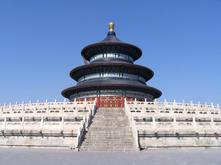
The Temple of Heaven is seen as the most holy of Beijing's imperial temples. It has been described as "a masterpiece of architecture and landscape design".
The Temple of Heaven was where the emperor came every winter solstice to worship Heaven and to solemnly pray for a good harvest. Since his rule was legitimized by a perceived mandate from Heaven, a bad harvest could be interpreted as his fall from Heaven's favor and threaten the stability of his reign. So, it was not without a measure of self-interest that the emperor fervently prayed for a very good crop
The design of the Temple of Heaven complex, true to its sacred purpose, reflects the mystical cosmological laws believed to be central to the workings of the universe. Hence, complex numerological permutations operate within its design. For example, because the number nine was considered to be the most powerful digit, you will see that the slabs that form the Circular Altar have been lain in multiples of nine. Similarly within the Hall of Prayer for Good Harvest, the interior twenty-eight columns are divided into four central pillars to represent the seasons, twelve inner columns to represent the months and twelve outer columns to represent the two hour tranches that make up a day. There are many such examples of this intense numerology at play
The Temple of Heaven was where the emperor came every winter solstice to worship Heaven and to solemnly pray for a good harvest. Since his rule was legitimized by a perceived mandate from Heaven, a bad harvest could be interpreted as his fall from Heaven's favor and threaten the stability of his reign. So, it was not without a measure of self-interest that the emperor fervently prayed for a very good crop
The design of the Temple of Heaven complex, true to its sacred purpose, reflects the mystical cosmological laws believed to be central to the workings of the universe. Hence, complex numerological permutations operate within its design. For example, because the number nine was considered to be the most powerful digit, you will see that the slabs that form the Circular Altar have been lain in multiples of nine. Similarly within the Hall of Prayer for Good Harvest, the interior twenty-eight columns are divided into four central pillars to represent the seasons, twelve inner columns to represent the months and twelve outer columns to represent the two hour tranches that make up a day. There are many such examples of this intense numerology at play
10.Tian’anmen Square
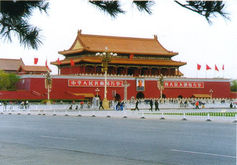
Tian'anmen Square is the largest city square in the world, at 440,000 square meters, and can hold about one million people for public celebration or gatherings. In the square tourists can climb the Tiananmen Rostrum, attend the national flag raising ceremony every morning at sunrise, visit the National Museum of China, and go to the Mausoleum of Mao Zedong, in which one will see the body of the great Chinese leader.
Tian'anmen Square holds the Monument of the National Heroes, the Great Hall of the People, the National Museum of China and the Mausoleum of Mao Zedong. To the north is the Forbidden City and to the south the Temple of Heaven.
A ceremony for the raising and lowering of the Chinese national flag is held at sunrise and sunset everyday.
Tian'anmen Square holds the Monument of the National Heroes, the Great Hall of the People, the National Museum of China and the Mausoleum of Mao Zedong. To the north is the Forbidden City and to the south the Temple of Heaven.
A ceremony for the raising and lowering of the Chinese national flag is held at sunrise and sunset everyday.
11. Lama Temple
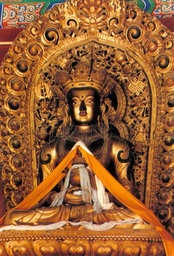
Lama Temple Beijing (Yonghegong), or Palace of Peace and Harmony Lama Temple or Yonghegong Lamasery, a renowned lama temple of the Yellow Hat Sect of Lamaism, is situated in the northeast part of Beijing city. Lama Temple features five large halls and five courtyards with beautifully decorative archways, upturned eaves and carved details. It houses a treasury of Buddhist art, including sculptured images of gods, demons and Buddhas, as well as Tibetan-style murals.
After Yongzheng's death in 1735, his coffin was placed in the temple. Emperor Qianlong, his successor, upgraded Yonghegong to an imperial palace with its turquoise tiles replaced by yellow tiles (yellow was the imperial color in the Qing Dynasty). During the 9th year of Emperor Qian Long's reign (1744), it was converted into a lamasery and became a residence for large numbers of monks from Mongolia and Tibet.This is a kind of friendly policy that the Qing dynasty deal with the relation with Mongolia and Tibet. That is the reason why the Great Wall was not massive constructed during the Qing dynasty.
After Yongzheng's death in 1735, his coffin was placed in the temple. Emperor Qianlong, his successor, upgraded Yonghegong to an imperial palace with its turquoise tiles replaced by yellow tiles (yellow was the imperial color in the Qing Dynasty). During the 9th year of Emperor Qian Long's reign (1744), it was converted into a lamasery and became a residence for large numbers of monks from Mongolia and Tibet.This is a kind of friendly policy that the Qing dynasty deal with the relation with Mongolia and Tibet. That is the reason why the Great Wall was not massive constructed during the Qing dynasty.
12. Beijing Hutong
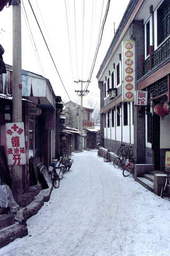
If you would like to have a glimpse into Beijing'Yesterday, you are highly recommended to have a short adventure trip to the Hutongs (old alleyways or siheyuan, the traditional courtyard residences). You may explore the narrow and curved alleys on foot, by pedicab or by bike.
A word " Hutong " which is what the small back streets or lanes of Beijing are called, is anunusual term used only in Beijing and a few northern cities in China, In fact, the word was originally a Han language term, but came from Monggolian roots.In the northern grasslands communities tended to from around wells, so " hot" or "well" in Monggolian, came also to mean a town, and a Hudu or Hudun, variants of it, a camp or village.
Later it was applied to a small street. The sound gradual- ly changed to Hutong. Small streets in Beijing baganbto be called Hutong after the NUZHEN people from the northeast, Who founded the Jin Dynasty, captured the city in 1127 and made it their capital.(their langusge has similaritiesto Mongolian ) The costom became more widespread when the city was the capital of the Yuan Dynasty after the Mongol conquest.
With the development of the city, many hutongs have been demolished to make way for building high rises, Without these hutongs, the memory of the traditional life and culture inbeijing will disappear. Therefore the city has set aside designated parts of dowmtown Beijing as off-limits to urban renovation. these areas include the neighbourhoods around the Forbidden City, Beihai Park and the Lama Temple.Experts worry that urban renovation is likely to break the traditional to fathom the life of old Beijing.
A word " Hutong " which is what the small back streets or lanes of Beijing are called, is anunusual term used only in Beijing and a few northern cities in China, In fact, the word was originally a Han language term, but came from Monggolian roots.In the northern grasslands communities tended to from around wells, so " hot" or "well" in Monggolian, came also to mean a town, and a Hudu or Hudun, variants of it, a camp or village.
Later it was applied to a small street. The sound gradual- ly changed to Hutong. Small streets in Beijing baganbto be called Hutong after the NUZHEN people from the northeast, Who founded the Jin Dynasty, captured the city in 1127 and made it their capital.(their langusge has similaritiesto Mongolian ) The costom became more widespread when the city was the capital of the Yuan Dynasty after the Mongol conquest.
With the development of the city, many hutongs have been demolished to make way for building high rises, Without these hutongs, the memory of the traditional life and culture inbeijing will disappear. Therefore the city has set aside designated parts of dowmtown Beijing as off-limits to urban renovation. these areas include the neighbourhoods around the Forbidden City, Beihai Park and the Lama Temple.Experts worry that urban renovation is likely to break the traditional to fathom the life of old Beijing.
13.Drum&Bell Tower
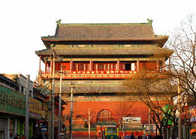
Gǔlóu (鼓楼), the drum tower of Bejing, is situated at the northern end of the central axis of the Inner City to the north of Di’ anmen Street. Originally built for musical reasons, it was later used to announce the time and is now a tourist attraction.
Zhōnglóu (钟楼), the bell tower of Beijing, stands closely behind the drum tower. Together with the drum tower, they provide an overview of central Beijing and before the modern era, they both dominated Beijing's ancient skyline.
Bells and Drums were Musical instruments in ancient China. Later they were used by government and common people as timepieces. The Bell and Drum towers were the center of Chinese chronology during the Yuan, Ming and Qing dynasties.The Bell and Drum Towers continued to function as the official timepiece of China and government until 1924, when the last emperor of the Qing Dynasty was forced to leave the Forbidden cith and western-style clockwork was made the official means of time-keeping.
Zhōnglóu (钟楼), the bell tower of Beijing, stands closely behind the drum tower. Together with the drum tower, they provide an overview of central Beijing and before the modern era, they both dominated Beijing's ancient skyline.
Bells and Drums were Musical instruments in ancient China. Later they were used by government and common people as timepieces. The Bell and Drum towers were the center of Chinese chronology during the Yuan, Ming and Qing dynasties.The Bell and Drum Towers continued to function as the official timepiece of China and government until 1924, when the last emperor of the Qing Dynasty was forced to leave the Forbidden cith and western-style clockwork was made the official means of time-keeping.
14.Beihai park
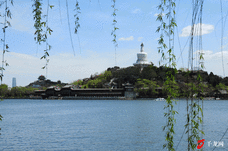
Beihai Park located in central Beijing, is one of the oldest and most authentically perserved imperial gardens in China. It has a history of 1000 years.
Beihai has existed throughout the Liao, Jin, Yuan, Ming and Qing Dynasties. Most of the buildings now standing were constructed during Emperor Qianlong's regin in the Qing Dynasty (1644-1911 A.D.).
Beihai was opened to the public in 1925 and in 1961 it was one of the first important cultural sites placed under protection by the State Council. The park occupies an area of 69 hectares including a 39-hectare lake. In the garden, pavilions and towers nestle amid the beautiful scenery of lakes and hills,grass and trees. Carrying on the traditions of garden landscaping of ancient China Beihai is a gem of garden art.
Beihai has existed throughout the Liao, Jin, Yuan, Ming and Qing Dynasties. Most of the buildings now standing were constructed during Emperor Qianlong's regin in the Qing Dynasty (1644-1911 A.D.).
Beihai was opened to the public in 1925 and in 1961 it was one of the first important cultural sites placed under protection by the State Council. The park occupies an area of 69 hectares including a 39-hectare lake. In the garden, pavilions and towers nestle amid the beautiful scenery of lakes and hills,grass and trees. Carrying on the traditions of garden landscaping of ancient China Beihai is a gem of garden art.
15.Tsinghua University
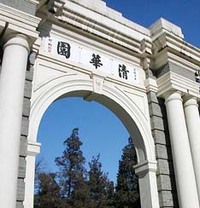
Tsinghua University was established in 1911, originally under the name of Tsinghua Xuetang. The university section was founded in 1925 and undergraduate students were then enrolled. The name National Tsinghua University was adopted in 1928. It has developed into a comprehensive research university at a breathtaking pace. At present, the university has 14 schools, 56 departments with faculties in science, engineering, the humanities, law, medicine, history, philosophy, economics, management, education and art.
The university currently has over 4000 faculty members, including 1172 full professors and 1,061 associate professors. Among them, there are 36 members of the Chinese Academy of Sciences and 32 members of the Chinese Academy of Engineering.
As one of the country's leading institutions of learning and research, Tsinghua University has a strong commitment to basic research, applied research and scientific innovation. The total publications in SCI, EI and ISTP by Tsinghua faculties keep the first ranking among all of the universities in China.
There are over 28,000 students studying at Tsinghua including 14,000 undergraduates and 14,000 graduate students. The Tsinghua graduate school offers 228 doctoral programs and 249 master degree programs. Over 2400 students from 103 countries in the world are studying here annually.
Tsinghua campuses cover an area of 406 hectares which accommodate all of the full time students. Research and teaching facilities include 7 libraries, 6 public teaching buildings, 155 research institutes and many school and department buildings. Other service facilities, such as dormitory buildings, supermarkets, bookstores, banks, post offices, hospital, sports centers, outdoor and indoor swimming pools, restaurants and dining halls, make daily life on campus very convenient.
The university currently has over 4000 faculty members, including 1172 full professors and 1,061 associate professors. Among them, there are 36 members of the Chinese Academy of Sciences and 32 members of the Chinese Academy of Engineering.
As one of the country's leading institutions of learning and research, Tsinghua University has a strong commitment to basic research, applied research and scientific innovation. The total publications in SCI, EI and ISTP by Tsinghua faculties keep the first ranking among all of the universities in China.
There are over 28,000 students studying at Tsinghua including 14,000 undergraduates and 14,000 graduate students. The Tsinghua graduate school offers 228 doctoral programs and 249 master degree programs. Over 2400 students from 103 countries in the world are studying here annually.
Tsinghua campuses cover an area of 406 hectares which accommodate all of the full time students. Research and teaching facilities include 7 libraries, 6 public teaching buildings, 155 research institutes and many school and department buildings. Other service facilities, such as dormitory buildings, supermarkets, bookstores, banks, post offices, hospital, sports centers, outdoor and indoor swimming pools, restaurants and dining halls, make daily life on campus very convenient.
16.Marco polo Bridge
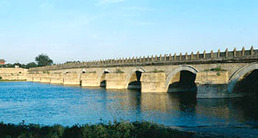
Lugou Qiao, also known as the Marco Polo Bridge, is one of earliest segmented stone arch bridge about 16 km in the outside of Beijing
The bridge is 260 meters long and has 250 marble balustrades supporting 485 carved stone lions. First built in 1192, the original arches were washed away in the 17th century. The bridge is a composite of different eras, widened in 1969 to span the Yongding River near the town of Wanping.
In the Mingchang period (1190-1208) of the Jin dynasty, the bridge was listed into the "Eight Scenic Spots of Yanjing (Beijing)" under the title "Lugou Xiaoyue" (Moon Over Lugou at Daybreak), which has remained throughout the Yuan, Ming, and Qing dynasties.
In 1751, Emperor Qianlong of the Qing dynasty (1644-1911) personally edited the poetic titles for the 8 views, and wrote the inscriptions for the steles, including the "Lugou Xiaoyue" tablet which still stands by the bridge.
The Luguo Bridge has been standing over the Yongding River for 800 years. The entire bridge is made of huge granite blocks, with carved stone lions crouched along the railings on both sides. No two lions are alike, and smaller carved lions can be found strategically placed on and beside them.
In ancient times the bridge was renowned for its spectacular views of the moon during the Mid-autumn Festival.
On July 7th, 1937, the bridge featured again in China's history when the Japanese Kwantung Army began its war to conquer China. It is known for the "Marco Polo Bridge Incident". During the next 8 years, Japan occupied most of China and killed millions of Chinese.
On July 7, 1937, Japanese troops illegally occupied a railway junction near Wanping and fighting erupted. This is considered by many to be the date when the war between China and Japan began. The war ended with the end of WWII
The bridge is 260 meters long and has 250 marble balustrades supporting 485 carved stone lions. First built in 1192, the original arches were washed away in the 17th century. The bridge is a composite of different eras, widened in 1969 to span the Yongding River near the town of Wanping.
In the Mingchang period (1190-1208) of the Jin dynasty, the bridge was listed into the "Eight Scenic Spots of Yanjing (Beijing)" under the title "Lugou Xiaoyue" (Moon Over Lugou at Daybreak), which has remained throughout the Yuan, Ming, and Qing dynasties.
In 1751, Emperor Qianlong of the Qing dynasty (1644-1911) personally edited the poetic titles for the 8 views, and wrote the inscriptions for the steles, including the "Lugou Xiaoyue" tablet which still stands by the bridge.
The Luguo Bridge has been standing over the Yongding River for 800 years. The entire bridge is made of huge granite blocks, with carved stone lions crouched along the railings on both sides. No two lions are alike, and smaller carved lions can be found strategically placed on and beside them.
In ancient times the bridge was renowned for its spectacular views of the moon during the Mid-autumn Festival.
On July 7th, 1937, the bridge featured again in China's history when the Japanese Kwantung Army began its war to conquer China. It is known for the "Marco Polo Bridge Incident". During the next 8 years, Japan occupied most of China and killed millions of Chinese.
On July 7, 1937, Japanese troops illegally occupied a railway junction near Wanping and fighting erupted. This is considered by many to be the date when the war between China and Japan began. The war ended with the end of WWII
17.The Ruins of Yuanmingyuan

In a quiet section of the suburbs of Beijing to the northwest of Qinghua University, there once stood a complex of gardens known as the Yuanmingyuan. Built in the Qing Dynasty, this "garden of gardens" was made up of the Garden of Perfection and Light (Yuanmingyuan), and the Garden of Ten Thousand Springtimes (Wanchunyuan).
The work of building the garden went on over a period of 150 years, beginning in around 1700. The grounds had a circumference of 10 kilometers and occupied an area of more than 347 hectares. Of the hundreds of large and small buildings, which once stood here, all that remains are a few ruins in stone, a sorry reminder of past greatness.
On October 5, 1860, the Anglo-French Allied Armies occupied the town of Haidian in the northwest suburbs of the capital, and on October 7 the mad plunder of the garden began. Finally, Lord Elgin‘s cavalry set the gardens on fire, leaving them to burn for three days and three nights. After their retreat, repairs were begun, but in 1900 the Eight-Power Allied Forces, leaving it in completer ruin, brought further destruction upon the garden. Before long, members of the imperial household and the warlords of the early Republican period took whatever could be made use of from out of the rubble, including wood, stones, bricks or tiles, away.
The work of building the garden went on over a period of 150 years, beginning in around 1700. The grounds had a circumference of 10 kilometers and occupied an area of more than 347 hectares. Of the hundreds of large and small buildings, which once stood here, all that remains are a few ruins in stone, a sorry reminder of past greatness.
On October 5, 1860, the Anglo-French Allied Armies occupied the town of Haidian in the northwest suburbs of the capital, and on October 7 the mad plunder of the garden began. Finally, Lord Elgin‘s cavalry set the gardens on fire, leaving them to burn for three days and three nights. After their retreat, repairs were begun, but in 1900 the Eight-Power Allied Forces, leaving it in completer ruin, brought further destruction upon the garden. Before long, members of the imperial household and the warlords of the early Republican period took whatever could be made use of from out of the rubble, including wood, stones, bricks or tiles, away.
18.Bird Nest
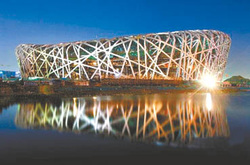
The Beijing National Stadium, also known as the bird's nest will be the main track and field stadium for the 2008 Summer Olympics and will be host to the Opening and Closing ceremonies. In 2002 Government officials engaged architects worldwide in a design competition. Pritzker Prize-winning architects Herzog & de Meuron collaborated with ArupSport and China Architecture Design & Research Group to win the competition. The stadium will seat as many as 100,000 spectators during the Olympics, but this will be reduced to 80,000 after the games. It has replaced the original intended venue of the Guangdong Olympic Stadium. The stadium is 330 metres long by 220 metres wide, and is 69.2 metres tall. The 250,000 square metre (gross floor area) stadium is to be built with 36 km of unwrapped steel, with a combined weight of 45,000 tonnes. The stadium will cost up to 3.5 billion yuan (422,873,850 USD/ 325,395,593 EUR). The ground was broken in December 2003, and construction started in March 2004, but was halted by the high construction cost in August 2004.
19. Water Cube

After more than four years of construction, the Water Cube was made available on January 28, in time to host the "Good Luck Beijing" Swimming China Open.
Beijing This Month has tracked the building of the Water Cube since its inception. Below are some of the features of this magnificent wonder:Cost-Effective Bubbles,Strong Cushions,Breathing Building,House with Sun Shade,Fire Resistant.The Theory of Foam-Physics.
Beijing This Month has tracked the building of the Water Cube since its inception. Below are some of the features of this magnificent wonder:Cost-Effective Bubbles,Strong Cushions,Breathing Building,House with Sun Shade,Fire Resistant.The Theory of Foam-Physics.
20.Panda Garden
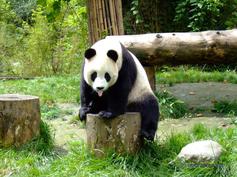
Beijing Zoo was initially named Ten Thousand Animal Garden which was built in 1908, proving that it already has had a history of more than 90 years. It is located in Xicheng District of Beijing City, beside Beijing Exhibition Hall, facing Beijing Astronomical Observatory. The Zoo was originally the imperial manor in the Ming Dynasty (1368 - 1644). Plants were cultivated and animals were raised here during the Qing Dynasty (1644 - 1911). After the liberation, it was reconstructed and was known as the West Suburb Park. And in 1955, the name was changed to Beijing Zoo.
Beijing Zoo mainly exhibits wild and rare animals growing in China, such as the Panda and the Golden Monkey. Also, it boasts many rare animals from all around the world, such as White Bear from the North Pole, Kangaroo from Australia, Zebra from Africa. Moreover, heads of states gave some of the animals.
The buildings in the Zoo cover an area of more than 50,000 square meters, including the monkey hill, the panda hall, the lion and tiger hill, the elephant hall, the see beast hall, and many others. Altogether there are more than 30 large halls. It has a collection of more than 600 types of animal species and more than 7, 000 population of animals.
Beijing Zoo mainly exhibits wild and rare animals growing in China, such as the Panda and the Golden Monkey. Also, it boasts many rare animals from all around the world, such as White Bear from the North Pole, Kangaroo from Australia, Zebra from Africa. Moreover, heads of states gave some of the animals.
The buildings in the Zoo cover an area of more than 50,000 square meters, including the monkey hill, the panda hall, the lion and tiger hill, the elephant hall, the see beast hall, and many others. Altogether there are more than 30 large halls. It has a collection of more than 600 types of animal species and more than 7, 000 population of animals.
21.National Grand Theater
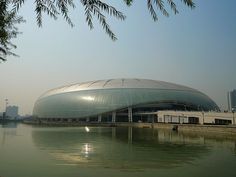
In Beijing is not all about Olympics. The National Grand Theater , by paul Andreu is a magnificent and gigantic project finished a few months ago, complementing all the infrastructure been built for the big sports event.
The project description after the break.
The Beijing National Grand Theatre: a cultural island in the middle of a lake.
The building is situated in the heart of Bejing on Chang An Avenue next to the Great Hall of the People and about 500 meters from Tian An Men Square and the Forbidden City.
It is a curved building, with a total surface area of 149,500 square meters, that emerges like an island at the center of a lake. The titanium shell is in the shape of a super ellipsoid with a maximum span of 213 meters, a minimum span of 144 meters and a height of 46 meters). It is divided in two by a curved glass covering, 100 meters wide at the base.
During the day, light flows through the glass roof into the building. At night, the movements within can be seen from outside. The building houses three performance auditoriums – a 2,416-seat opera house, a 2,017 seat concert hall and a 1,040 theatre – as well as art and exhibition spaces opened to a wide public and integrated into the city.
The project description after the break.
The Beijing National Grand Theatre: a cultural island in the middle of a lake.
The building is situated in the heart of Bejing on Chang An Avenue next to the Great Hall of the People and about 500 meters from Tian An Men Square and the Forbidden City.
It is a curved building, with a total surface area of 149,500 square meters, that emerges like an island at the center of a lake. The titanium shell is in the shape of a super ellipsoid with a maximum span of 213 meters, a minimum span of 144 meters and a height of 46 meters). It is divided in two by a curved glass covering, 100 meters wide at the base.
During the day, light flows through the glass roof into the building. At night, the movements within can be seen from outside. The building houses three performance auditoriums – a 2,416-seat opera house, a 2,017 seat concert hall and a 1,040 theatre – as well as art and exhibition spaces opened to a wide public and integrated into the city.
22.Beijing Aquarium

A giant aquarium (42,000 square meters) opened in 1999 and is one of the world's largest, with many huge water tanks, some one can walk through, a dolphin and sea lion show, and many themed areas showing marine life from around the world.
23. CCTV tower
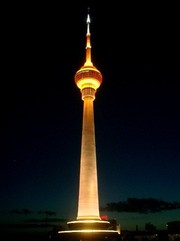
CCTV Tower is located to the south of Beijing West Railway Station. Occupying 15.4 hectares with 405-meter high, it is the tallest building in Beijing. The CCTV tower was built in 1992 and its primary function is the broadcast of radio and TV channels, including CCTV (China Central Television) channels. From the observation deck and revolving restaurant you will have a bird's eye view of Beijing.
Beijing Pacific Underwater World is located beneath the TV tower and has comprehensive displays of sea life. There is also a children's playground and a go-karting track.
24.China Millennium Monument
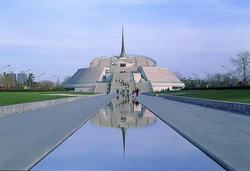
China Millennium Monument is the landmark building which Chinese People welcome new millenary and century, as a gift to the world , it will stand in Beijing forever. Covering an area of 4.5 hectares, sitting between Revolutionary Military Affairs Museum of China and CCTV, north to the beautiful scenery park named Yuyuantan Park, south to West Beijing Railway Station.The main building of the China Century Monument is composed of the revolving gradient altar platform and the static cloisters. At the center of the gradient altar platform is a small horizontal round platform about 14 meters (46 feet) in diameter, where various kinds of performances can be held. on the exterior wall of the altar platform are carved 56 relief patterns representing 56 peoples in China. Inside the static cloisters are housed 40 bronze statues of Chinese celebrities.
Holy Fire Square lies near the south entrance of the China Century Monument. At the center of the square is the Holy Fire Platform. To the east and west of the square, two springs flow down the stairs, which represent the Yangtze River and the Yellolw River. The Holy Fire Square is paved with 960 pieces of granite symbolizing China's 9,600,000 square kilometers' (3,706,581 square miles) territory. At the south entrance stands a white marble tablet engraved with five Chinese characters 'Zhong', 'Hua', 'Shi', 'Ji' and 'Tan' which were written by Jiang Zemin, the former president of People's Republic of China.
Holy Fire Square lies near the south entrance of the China Century Monument. At the center of the square is the Holy Fire Platform. To the east and west of the square, two springs flow down the stairs, which represent the Yangtze River and the Yellolw River. The Holy Fire Square is paved with 960 pieces of granite symbolizing China's 9,600,000 square kilometers' (3,706,581 square miles) territory. At the south entrance stands a white marble tablet engraved with five Chinese characters 'Zhong', 'Hua', 'Shi', 'Ji' and 'Tan' which were written by Jiang Zemin, the former president of People's Republic of China.
